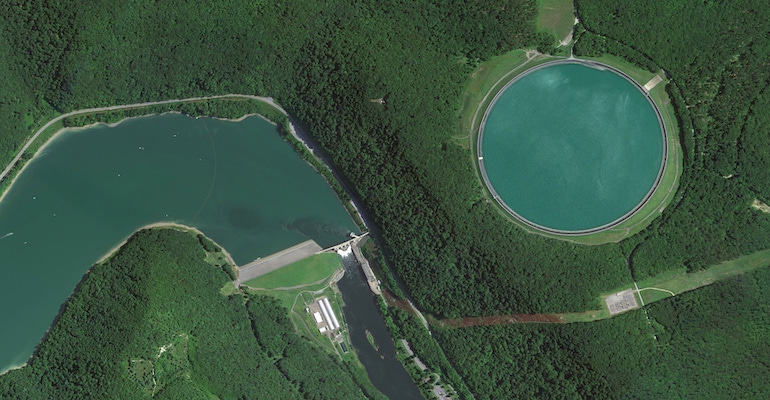Do you Want to Build Really Big Grid Storage? Pump Water Uphill!
Pumped storage hydropower is the biggest method in use to keep the grid up and running.
September 7, 2021

As much as we talk about lithium-ion or redox flow batteries for grid-scale energy storage, 93 percent of US energy storage comes from pumped storage hydropower, also known as water batteries. In 2021, 18 states in all major regions of the country use pumped storage hydropower to store energy. California, Virginia, and South Carolina are the biggest users of the technology, and three new states have projects in progress (bringing the total up to 21).
Pumped storage hydropower uses two big pools of water, one high above the other. When energy sources like solar and wind make more electricity than the grid needs, the extra electrical power is used to pump water up into the water battery’s top pool, “charging” the water battery. When the grid needs extra power, during a heatwave, for example, the water is released from that top pool and flows down, spinning a turbine that creating electricity that goes into the power grid. These are some of the biggest batteries on Earth.
The Department of Energy’s (DOE) Office of Energy Efficiency and Renewable Energy published an article on water batteries to celebrate National Hydropower Day on August 24.
Here are some of the DOE’s takeaways:
Mother nature is no problem for water batteries. Renewable energy is crucial for a clean energy future, but sometimes, mother nature makes it challenging. Water batteries can fill energy gaps on cloudy and still days, making sure clean energy is still reliable energy.
In the United States, pumped storage hydropower can store up to 553 gigawatt-hours of energy. That could power video gaming across the entire country for about a week. Every year, American video gamers use about as much energy as 85 million refrigerators or 5 million cars.
Pumped storage is the most efficient large energy storage system currently available—clocking in at 70-80%! Because it takes energy to store energy, no storage system—not even typical batteries—is 100% efficient. Pumping water into a water battery’s top reservoir requires a burst of energy. Still, a good 80% of what goes up, comes back down.
Hydropower and pumped-storage facilities provide 40% of the power needed to jumpstart a grid after a blackout. Ice storms, wildfires, and even hackers could stop the electric grid from powering our homes and offices. When emergencies knock out other energy sources, water batteries can turn on fast to keep people safe and comfortable.
Natural disasters are no match for hydropower and pumped storage’s flood control and irrigation benefits! Water batteries can save you from those, too—they help absorb that extra water and use it to power your home (or help put out those wildfires that can harm the grid). The pools of water can also give clean water to crops, and you, too, making sure you don’t go thirsty during a heatwave.
The US pumped storage hydropower grew without any new construction. How does that work? Through “capacity increases” or upgrades to facilities that make them more powerful. From 2010 to 2019, upgrades at just six pumped storage facilities led to a 1,400 MW in capacity increase for the U.S. pumped storage. That means that within the capacity of U.S. pumped storage—without any new construction—pumped storage grew by almost as much as all other types of energy storage combined.
Water batteries are 90 years old. The first U.S. water battery—dubbed the 10-mile storage battery—popped up in Connecticut in 1930. Almost a century later, water batteries still provide energy at a low price.
The only real downsides to water batteries are the amount of space (acres up to square miles) that they require and the time it takes to open the valves and get the turbine spinning so that it produces electricity. Lithium-ion and flow batteries are much more compact and can begin to return energy in mere seconds. So, in the future, it will be a combination of different technologies that will allow the implementation of more renewable energy and keep the grid powered up and reliable.
Kevin Clemens is a Senior Editor with Battery Technology.
About the Author(s)
You May Also Like





